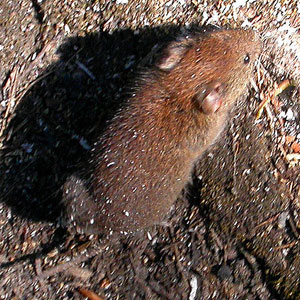

|
Southern Red-backed Vole Myodes gapperi Description: Red-backed voles are small dark gray mammals with a pronounced chestnut brown stripe running along the back from head to tail. They have dense, long, soft fur in winter that changes to shorter, coarser fur in summer. The face and sides appear yellowish brown and the underparts are dark slate-gray to almost white. Ears are short and round. Males and females are similar in size and color.
Size: The head and body length of red-backed voles varies between 70 and 112 mm. The tail is 25 to 60 mm long. Weighs between 6 and 42 grams 
Range / Habitat: Red-backed voles inhabit cool, mossy coniferous forests with stumps, logs, or brush piles used for nesting. Diet: Red-backed voles are omnivores and their diet changes with the season. They eat insects, seeds, grains, nuts, flowers, leaves, roots, bark, lichens, and fungi.
Reproduction: Breeding may begin as early as late winter and continue to late fall. Gestation is 17 to 19 days, and litter size is from 1 to 11 young Females are generally able to rear 2 or 3 litters each year. The offspring are born naked and blind. The young stay with a protective nest built by the mother. They are able to stand when 4 days old, have fur by day 8, and open their eyes by 15 days. The young nurse and are weaned at 17 to 21 days. Sexual maturity occurs around 3 months. Average life span in the wild is 10 to 12 months. Nests are typically constructed under the roots of stumps, logs, or brush piles. Some nests are located in holes or branches of trees high above the ground. Did you know?

Southern Red-backed Vole. (photo by D. Gordon E. Robertson)
More Information Myodes gapperi Information - Animal Diversity Web Photo credits: top photo © Phil Myers - Museum of Zoology, University of Michigan Home | About Us | How to Participate | Biodiversity Modules | Projects | Maps | News | Resources |